系列文章
- 使用 abp cli 搭建项目
- 给项目瘦身,让它跑起来
- 完善与美化,Swagger登场
- 数据访问和代码优先
- 自定义仓储之增删改查
- 统一规范API,包装返回模型
- 再说Swagger,分组、描述、小绿锁
- 接入GitHub,用JWT保护你的API
- 异常处理和日志记录
- 使用Redis缓存数据
- 集成Hangfire实现定时任务处理
- 用AutoMapper搞定对象映射
- 定时任务最佳实战(一)
- 定时任务最佳实战(二)
- 定时任务最佳实战(三)
博客接口实战篇(一)
上篇文章完成了两个接口:文章列表页、文章详情页,本篇继续。
分类列表
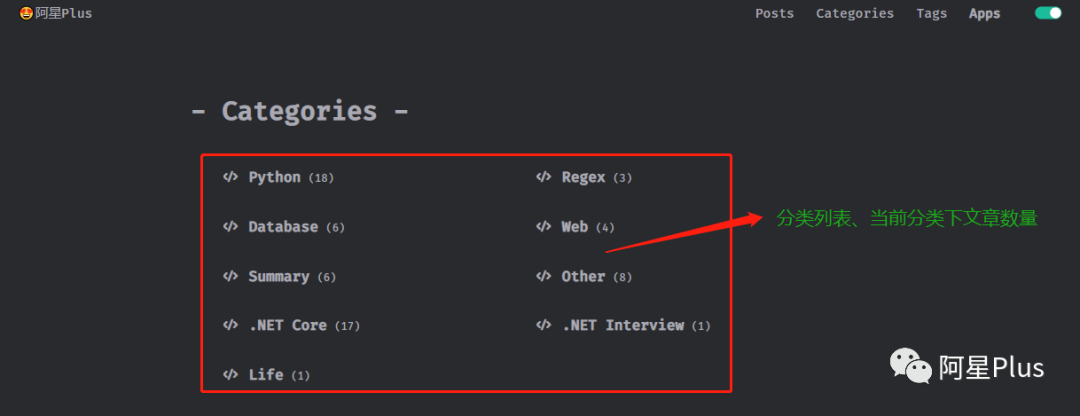
分析:这里多了一个统计文章数量的字段,可以直接新建一个模型QueryCategoryDto.cs继承CategoryDto。
//QueryCategoryDto.csnamespace Meowv.Blog.Application.Contracts.Blog{ public class QueryCategoryDto : CategoryDto { /// /// 总数 /// public int Count { get; set; } }}添加查询分类列表接口和缓存接口。
//IBlogService.Category.csusing Meowv.Blog.Application.Contracts.Blog;using Meowv.Blog.ToolKits.Base;using System.Collections.Generic;using System.Threading.Tasks;namespace Meowv.Blog.Application.Blog{ public partial interface IBlogService { /// /// 查询分类列表 /// /// Task>> QueryCategoriesAsync(); }}//IBlogCacheService.Category.csusing Meowv.Blog.Application.Contracts.Blog;using Meowv.Blog.ToolKits.Base;using System;using System.Collections.Generic;using System.Threading.Tasks;namespace Meowv.Blog.Application.Caching.Blog{ public partial interface IBlogCacheService { /// /// 查询分类列表 /// /// /// Task>> QueryCategoriesAsync(Func>>> factory); }}分别实现这两个接口。
//BlogCacheService.Category.csusing Meowv.Blog.Application.Contracts.Blog;using Meowv.Blog.ToolKits.Base;using System;using System.Collections.Generic;using System.Threading.Tasks;using static Meowv.Blog.Domain.Shared.MeowvBlogConsts;namespace Meowv.Blog.Application.Caching.Blog.Impl{ public partial class BlogCacheService { private const string KEY_QueryCategories = "Blog:Category:QueryCategories"; /// /// 查询分类列表 /// /// /// public async Task>> QueryCategoriesAsync(Func>>> factory) { return await Cache.GetOrAddAsync(KEY_QueryCategories, factory, CacheStrategy.ONE_DAY); } }}//BlogService.Category.csusing Meowv.Blog.Application.Contracts.Blog;using Meowv.Blog.ToolKits.Base;using System.Collections.Generic;using System.Linq;using System.Threading.Tasks;namespace Meowv.Blog.Application.Blog.Impl{ public partial class BlogService { /// /// 查询分类列表 /// /// public async Task>> QueryCategoriesAsync() { return await _blogCacheService.QueryCategoriesAsync(async () => { var result = new ServiceResult>(); var list = from category in await _categoryRepository.GetListAsync() join posts in await _postRepository.GetListAsync() on category.Id equals posts.CategoryId group category by new { category.CategoryName, category.DisplayName } into g select new QueryCategoryDto { CategoryName = g.Key.CategoryName, DisplayName = g.Key.DisplayName, Count = g.Count() }; result.IsSuccess(list); return result; }); } }}缓存就不说了,查询分类列表,联合查询文章和分类两张表,关联字段为CategoryId,然后分组,计算出对应的数量,在BlogController中添加API。
/// /// 查询分类列表/// /// [HttpGet][Route("categories")]public async Task>> QueryCategoriesAsync(){ return await _blogService.QueryCategoriesAsync();}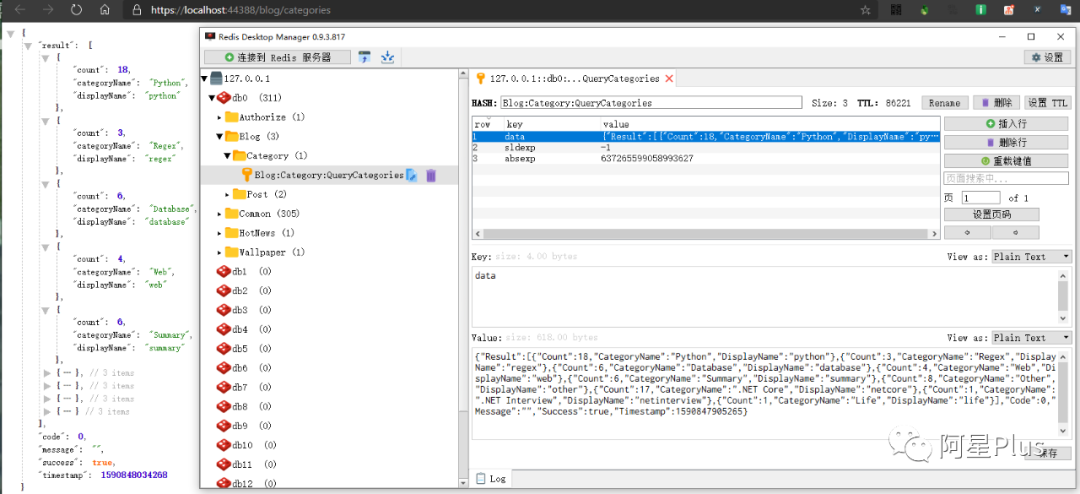
标签列表
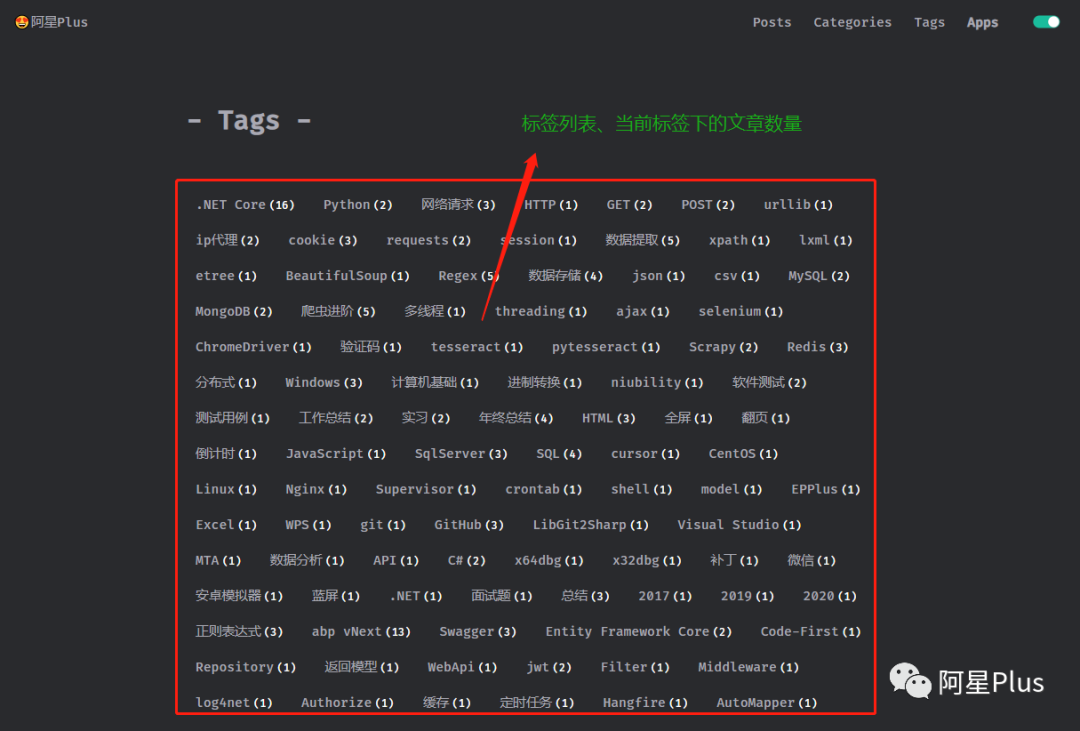
分析:和分类列表差不多,新建模型QueryTagDto.cs继承TagDto。
//QueryTagDto.csnamespace Meowv.Blog.Application.Contracts.Blog{ public class QueryTagDto : TagDto { /// /// 总数 /// public int Count { get; set; } }}添加查询标签列表接口和缓存接口。
//IBlogCacheService.Tag.csusing Meowv.Blog.Application.Contracts.Blog;using Meowv.Blog.ToolKits.Base;using System;using System.Collections.Generic;using System.Threading.Tasks;namespace Meowv.Blog.Application.Caching.Blog{ public partial interface IBlogCacheService { /// /// 查询标签列表 /// /// /// Task>> QueryTagsAsync(Func>>> factory); }}//IBlogService.Tag.csusing Meowv.Blog.Application.Contracts.Blog;using Meowv.Blog.ToolKits.Base;using System.Collections.Generic;using System.Threading.Tasks;namespace Meowv.Blog.Application.Blog{ public partial interface IBlogService { /// /// 查询标签列表 /// /// Task>> QueryTagsAsync(); }}分别实现这两个接口。
//BlogCacheService.Tag.csusing Meowv.Blog.Application.Contracts.Blog;using Meowv.Blog.ToolKits.Base;using System;using System.Collections.Generic;using System.Threading.Tasks;using static Meowv.Blog.Domain.Shared.MeowvBlogConsts;namespace Meowv.Blog.Application.Caching.Blog.Impl{ public partial class BlogCacheService { private const string KEY_QueryTags = "Blog:Tag:QueryTags"; /// /// 查询标签列表 /// /// /// public async Task>> QueryTagsAsync(Func>>> factory) { return await Cache.GetOrAddAsync(KEY_QueryTags, factory, CacheStrategy.ONE_DAY); } }}//BlogService.Tag.csusing Meowv.Blog.Application.Contracts.Blog;using Meowv.Blog.ToolKits.Base;using System.Collections.Generic;using System.Linq;using System.Threading.Tasks;namespace Meowv.Blog.Application.Blog.Impl{ public partial class BlogService { /// /// 查询标签列表 /// /// public async Task>> QueryTagsAsync() { return await _blogCacheService.QueryTagsAsync(async () => { var result = new ServiceResult>(); var list = from tags in await _tagRepository.GetListAsync() join post_tags in await _postTagRepository.GetListAsync() on tags.Id equals post_tags.TagId group tags by new { tags.TagName, tags.DisplayName } into g select new QueryTagDto { TagName = g.Key.TagName, DisplayName = g.Key.DisplayName, Count = g.Count() }; result.IsSuccess(list); return result; }); } }}查询标签列表需要联合查询tags和post_tags,根据TagId进行关联,然后分组从而获取标签下文章的总数,在BlogController中添加API。
/// /// 查询标签列表/// /// [HttpGet][Route("tags")]public async Task>> QueryTagsAsync(){ return await _blogService.QueryTagsAsync();}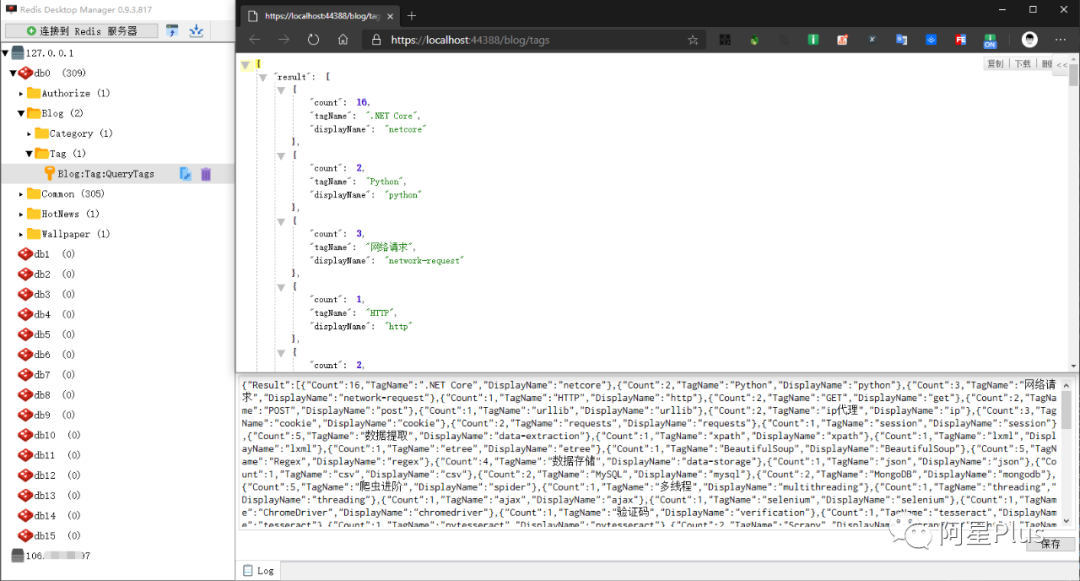
分类名称&文章列表
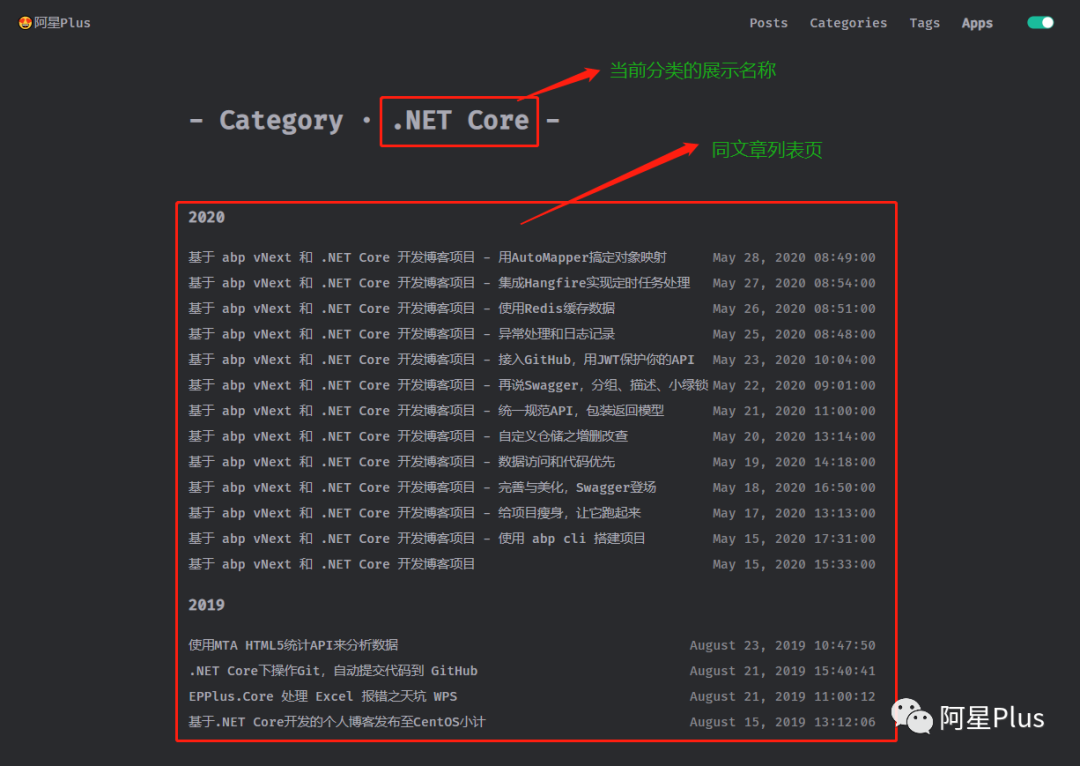
分析:此页面下包含两个接口,查询分类的名称和当前分类下的文章列表,和文章列表不同的是,它不带分页。分类包含两个字段,分类名称和展示名称,我们要把真正的名称查询出来展示在页面上。
分类名称
不需要给他添加返回模型,直接返回一个string类型即可,同时给一个查询参数name,添加获取分类名称接口和缓存接口。
//IBlogService.Category.cs/// /// 获取分类名称/// /// /// Taskstring>> GetCategoryAsync(//IBlogCacheService.Category.cs/// /// 获取分类名称/// /// /// /// Taskstring>> GetCategoryAsync(实现这两个接口。
//BlogCacheService.Category.cs... public partial class BlogCacheService { private const string KEY_GetCategory = "Blog:Category:GetCategory-{0}"; /// /// 获取分类名称 /// /// /// /// public async Taskstring>> GetCategoryAsync( { return await Cache.GetOrAddAsync(KEY_GetCategory.FormatWith(name), factory, CacheStrategy.ONE_DAY); } }...//BlogService.Category.cs/// /// 获取分类名称/// /// /// public async Taskstring>> GetCategoryAsync({ return await _blogCacheService.GetCategoryAsync(name, async () => { var result = new ServiceResult<string>(); var category = await _categoryRepository.FindAsync(x => x.DisplayName.Equals(name)); if (null == category) { result.IsFailed(ResponseText.WHAT_NOT_EXIST.FormatWith("分类", name)); return result; } result.IsSuccess(category.CategoryName); return result; });}FormatWith()是扩展方法,ResponseText.WHAT_NOT_EXIST是之前说过的常量,直接查询是否存在当前name的分类,如果不存在给出错误提示,存在的话,则只返回分类名称,在BlogController中添加API。
/// /// 获取分类名称/// /// /// [HttpGet][Route("category")]public async Taskstring>> GetCategoryAsync(([Required] { return await _blogService.GetCategoryAsync(name);}[Required]Attribute 指定参数name必填。
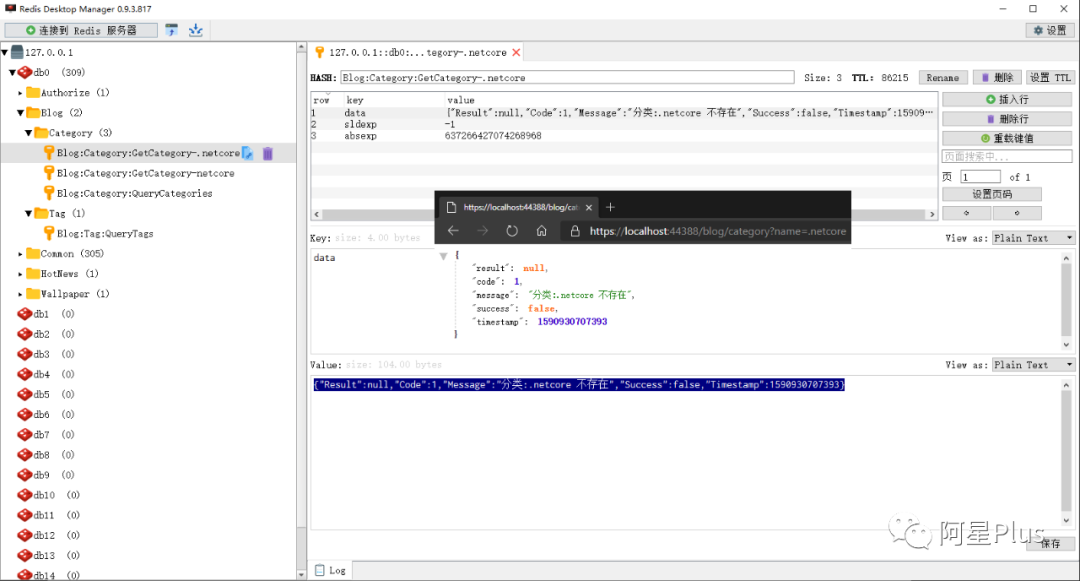
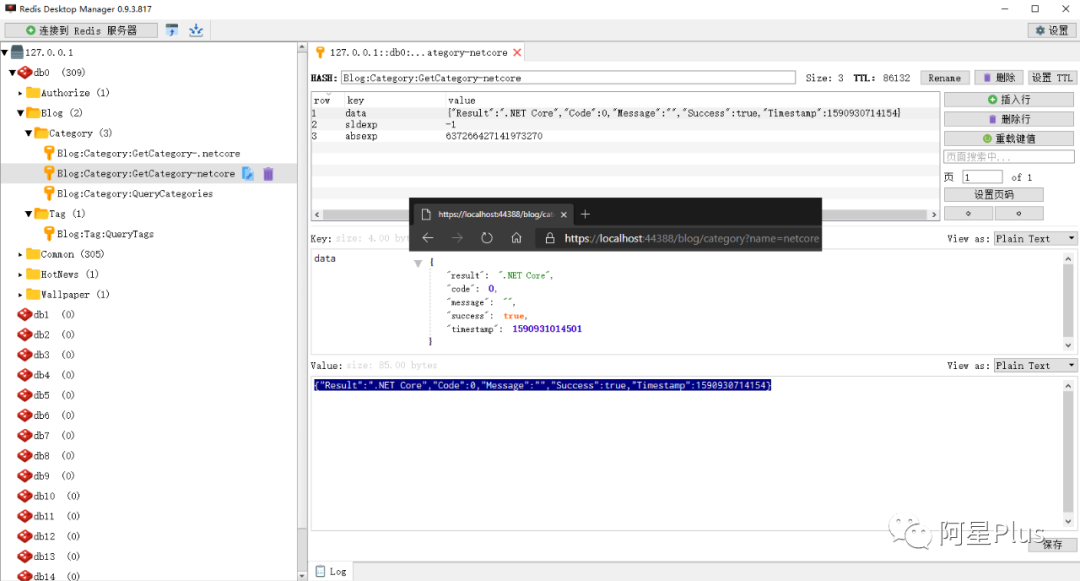
文章列表
通过分类名称查询文章列表和分页查询文章列表返回模型是一样的,只是不用分页,所以直接返回一个列表就可以了,添加通过分类名称查询文章列表和缓存的接口。
//IBlogService.Post.cs/// /// 通过分类名称查询文章列表/// /// /// Task>> QueryPostsByCategoryAsync(string name);//IBlogCacheService.Post.cs/// /// 通过分类名称查询文章列表/// /// /// /// Task>> QueryPostsByCategoryAsync(string name, Func>>> factory);分别实现这两个接口。
//BlogCacheService.Post.cs... public partial class BlogCacheService { private const string KEY_QueryPostsByCategory = "Blog:Post:QueryPostsByCategory-{0}"; /// /// 通过分类名称查询文章列表 /// /// /// /// public async Task>> QueryPostsByCategoryAsync(string name, Func>>> factory) { return await Cache.GetOrAddAsync(KEY_QueryPostsByCategory.FormatWith(name), factory, CacheStrategy.ONE_DAY); } }...//BlogService.Post.cs/// /// 通过分类名称查询文章列表/// /// /// public async Task>> QueryPostsByCategoryAsync(string name){ return await _blogCacheService.QueryPostsByCategoryAsync(name, async () => { var result = new ServiceResult>(); var list = (from posts in await _postRepository.GetListAsync() join categories in await _categoryRepository.GetListAsync() on posts.CategoryId equals categories.Id where categories.DisplayName.Equals(name) orderby posts.CreationTime descending select new PostBriefDto { Title = posts.Title, Url = posts.Url, Year = posts.CreationTime.Year, CreationTime = posts.CreationTime.TryToDateTime() }) .GroupBy(x => x.Year) .Select(x => new QueryPostDto { Year = x.Key, Posts = x.ToList() }); result.IsSuccess(list); return result; });}这个逻辑和分页查询文章列表是差不多的,联合查询文章表和分类表,关联字段为CategoryId,指定查询条件categories.DisplayName==name,以CreationTime倒序排序,年份分组,筛选出所需字段返回,在BlogController中添加API。
/// /// 通过分类名称查询文章列表/// /// /// [HttpGet][Route("posts/category")]public async Task>> QueryPostsByCategoryAsync([Required] string name){ return await _blogService.QueryPostsByCategoryAsync(name);}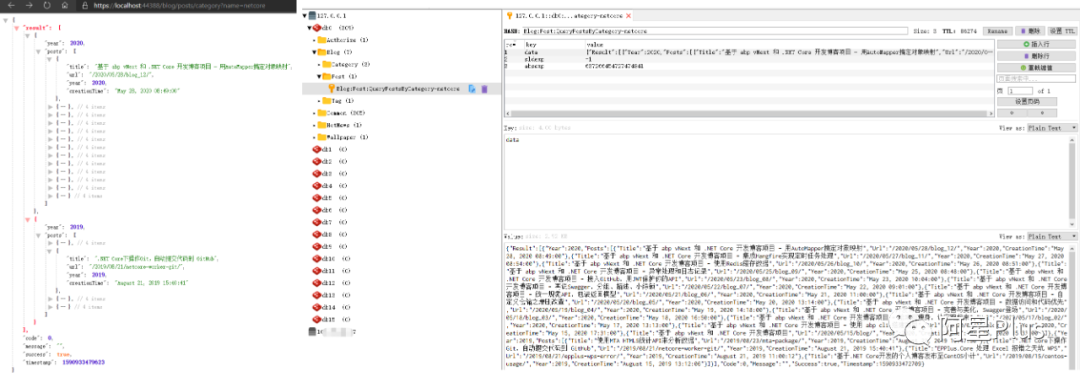
标签名称&文章列表
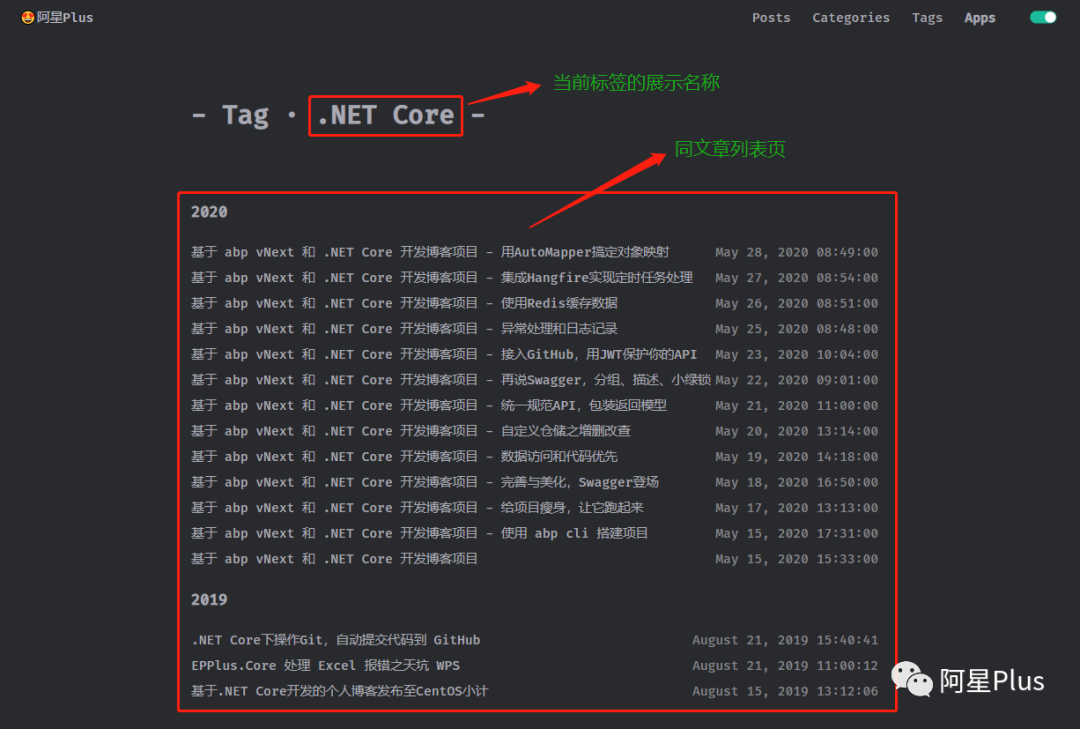
分析:此页面和分类页一样,包含两个接口,查询标签的名称和当前标签下的文章列表。
标签名称
添加获取标签名称接口和缓存接口,GetTagAsync()。
//IBlogService.Tag.cs/// /// 获取标签名称/// /// /// Taskstring>> GetTagAsync(//IBlogCacheService.Tag.cs/// /// 获取标签名称/// /// /// /// Taskstring>> GetTagAsync(实现这两个接口。
//BlogCacheService.Tag.cs... public partial class BlogCacheService { private const string KEY_GetTag = "Blog:Tag:GetTag-{0}"; /// /// 获取标签名称 /// /// /// /// public async Taskstring>> GetTagAsync( { return await Cache.GetOrAddAsync(KEY_GetTag.FormatWith(name), factory, CacheStrategy.ONE_DAY); } }...//BlogService.Tag.cs/// /// 获取标签名称/// /// /// public async Taskstring>> GetTagAsync({ return await _blogCacheService.GetTagAsync(name, async () => { var result = new ServiceResult<string>(); var tag = await _tagRepository.FindAsync(x => x.DisplayName.Equals(name)); if (null == tag) { result.IsFailed(ResponseText.WHAT_NOT_EXIST.FormatWith("标签", name)); return result; } result.IsSuccess(tag.TagName); return result; });}FormatWith()是扩展方法,ResponseText.WHAT_NOT_EXIST是之前说过的常量,直接查询是否存在当前name的分类,如果不存在给出错误提示,存在的话,则只返回分类名称,在BlogController中添加API。
/// /// 获取标签名称/// /// /// [HttpGet][Route("tag")]public async Taskstring>> GetTagAsync({ return await _blogService.GetTagAsync(name);}[Required]Attribute 指定参数name必填。
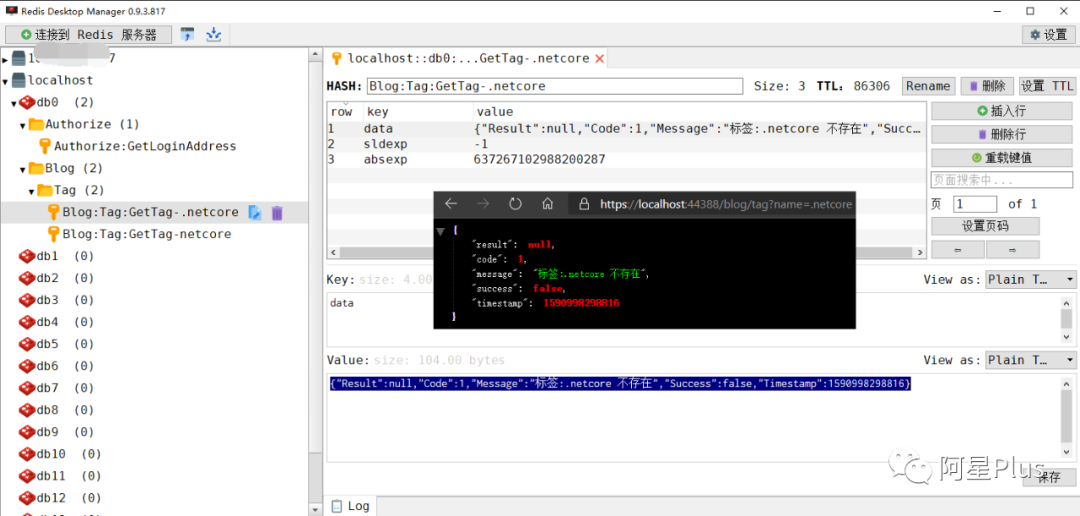
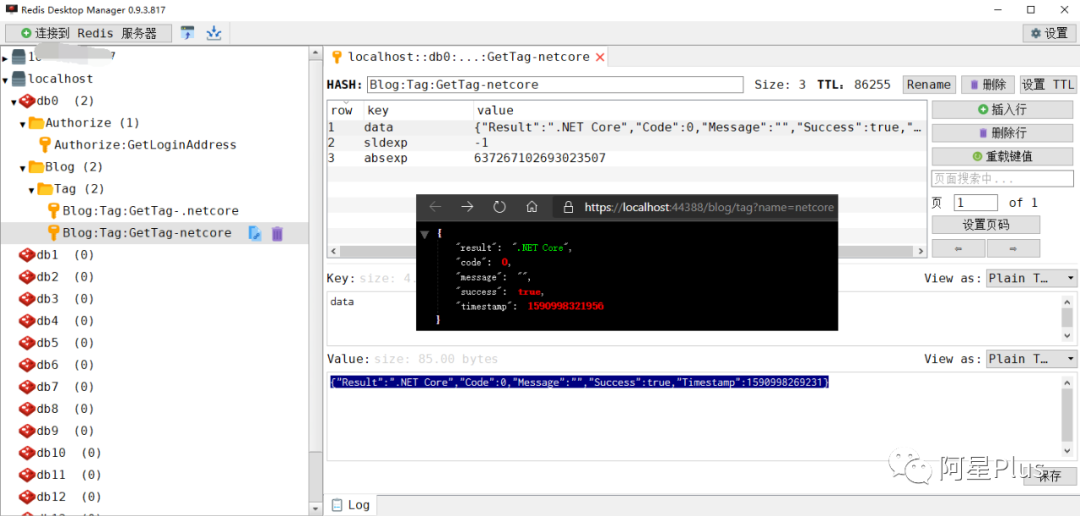
文章列表
和上面一模一样的,添加通过标签名称查询文章列表接口和缓存接口。
//IBlogService.Post.cs/// /// 通过标签名称查询文章列表/// /// /// Task>> QueryPostsByTagAsync(string name);//IBlogCacheService.Post.cs/// /// 通过标签名称查询文章列表/// /// /// /// Task>> QueryPostsByTagAsync(string name, Func>>> factory);分别实现这两个接口。
//BlogCacheService.Post.cs... public partial class BlogCacheService { private const string KEY_QueryPostsByTag = "Blog:Post:QueryPostsByTag-{0}"; /// /// 通过标签名称查询文章列表 /// /// /// /// public async Task>> QueryPostsByTagAsync(string name, Func>>> factory) { return await Cache.GetOrAddAsync(KEY_QueryPostsByTag.FormatWith(name), factory, CacheStrategy.ONE_DAY); } }...//BlogService.Post.cs/// /// 通过标签名称查询文章列表/// /// /// public async Task>> QueryPostsByTagAsync(string name){ return await _blogCacheService.QueryPostsByTagAsync(name, async () => { var result = new ServiceResult>(); var list = (from post_tags in await _postTagRepository.GetListAsync() join tags in await _tagRepository.GetListAsync() on post_tags.TagId equals tags.Id join posts in await _postRepository.GetListAsync() on post_tags.PostId equals posts.Id where tags.DisplayName.Equals(name) orderby posts.CreationTime descending select new PostBriefDto { Title = posts.Title, Url = posts.Url, Year = posts.CreationTime.Year, CreationTime = posts.CreationTime.TryToDateTime() }) .GroupBy(x => x.Year) .Select(x => new QueryPostDto { Year = x.Key, Posts = x.ToList() }); result.IsSuccess(list); return result; });}这个查询有点特殊,联合查询了3张表,先查post_tags和tags,关联字段TagId,再根据PostId查询posts,指定查询条件tags.DisplayName==name,以CreationTime倒序排序,年份分组,筛选出所需字段返回,在BlogController中添加API。
/// /// 通过标签名称查询文章列表/// /// /// [HttpGet][Route("posts/tag")]public async Task>> QueryPostsByTagAsync(string name){ return await _blogService.QueryPostsByTagAsync(name);}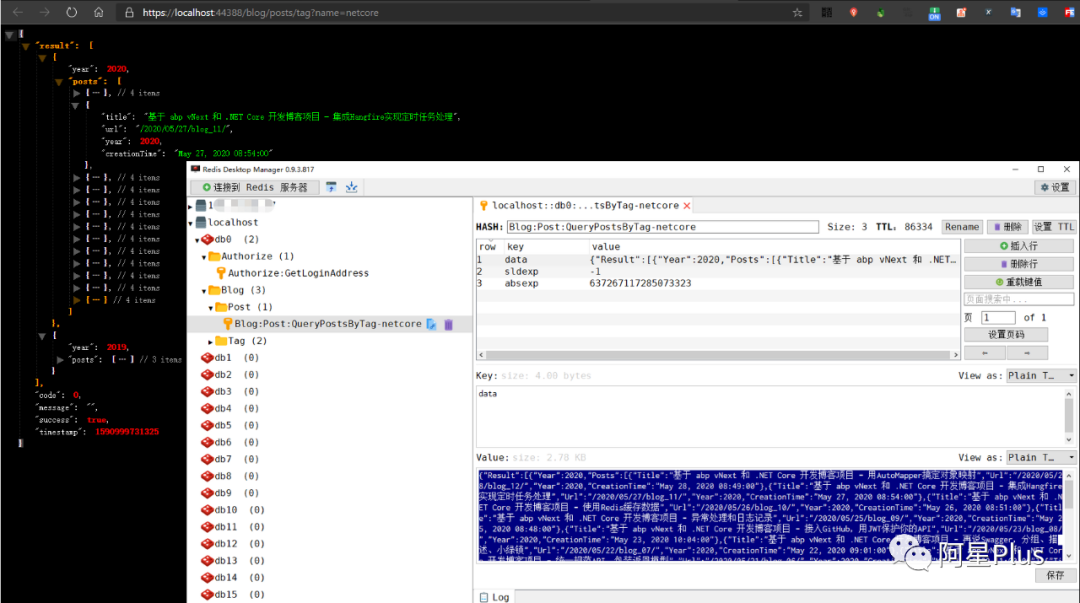
至此,基本上完成了博客前端所需的所有查询接口,就还剩下友链的查询,大家可以自己完成,后面如果需要什么新的接口再回头来写就好了。
开源地址:https://github.com/Meowv/Blog/tree/blog_tutorial
搭配下方课程学习更佳 ↓ ↓ ↓






















 1115
1115











 被折叠的 条评论
为什么被折叠?
被折叠的 条评论
为什么被折叠?








